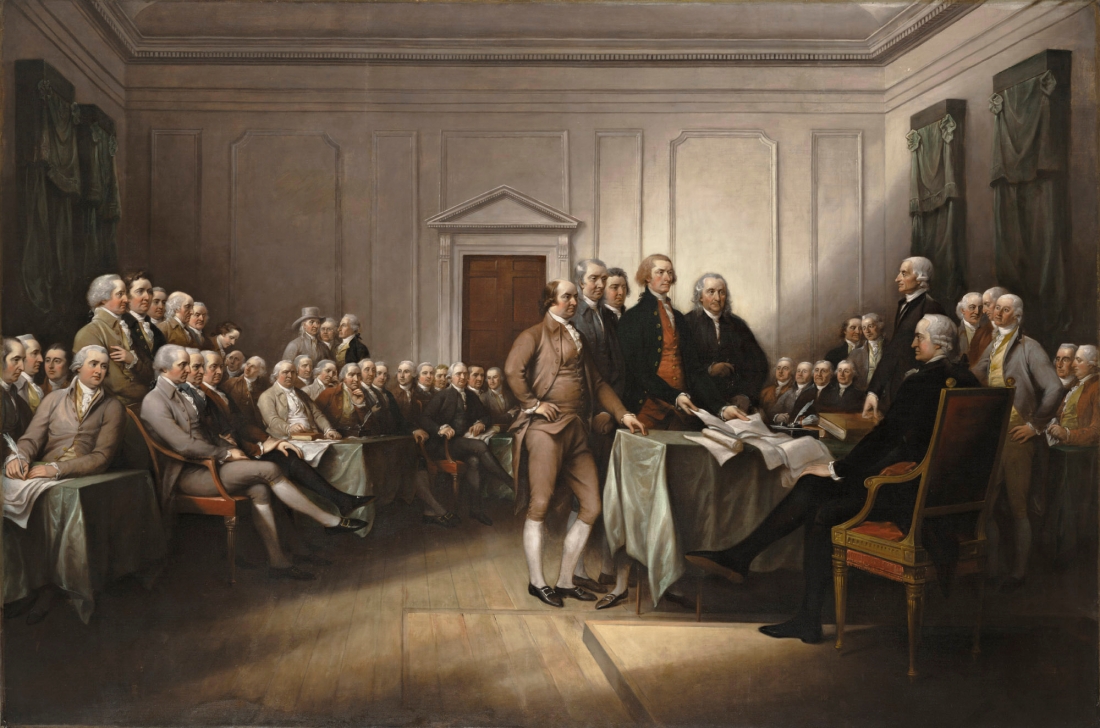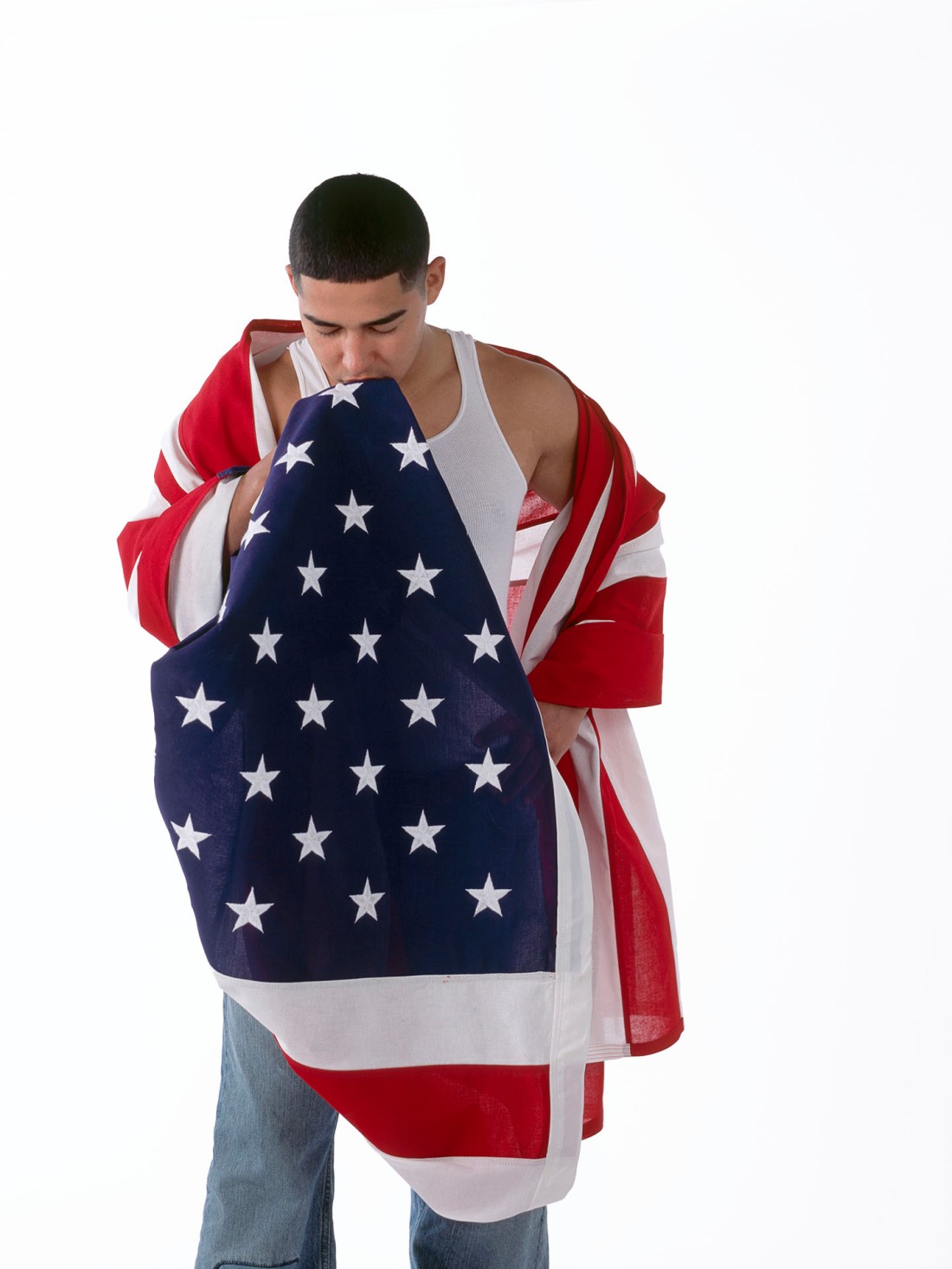Connecticut’s John Trumbull may be best known for his painting The Declaration of Independence, July 4, 1776. Despite its precise title, what Trumbull created by 1819 (and repeated twice again by 1832) was a carefully crafted record of an event that did not take place exactly as or when he portrayed it. In this painting there are meticulous portraits of 42 of the 56 delegates who would eventually sign a revised version of the declaration, but the initial presentation to Congress of a draft of the Declaration of Independence took place on June 28 (not July 4) and was far more sparsely attended. Trumbull worked hard to represent the spirit and personnel of the event, if not all the other specifics.

Even forgiving Trumbull’s casual regard for some of the details of the event, there was more amiss than just that.
By 1790 (soon after the ratification of the Constitution), about 2.6 million people lived in the newly formed United States. Despite the optimistic language and lofty ideals of the Declaration of Independence of 1776 and the Constitution of 1789, more than half of those millions were denied many of the brightest promises of either or both documents: that all men are created equal, that everyone has rights that are truly unalienable, or that the union was designed to provide justice and well-being for all Americans. At the time, nearly 700,000 U.S. residents were of African or Caribbean descent, and were enslaved (a few were marginally free). And perhaps a million more were women of European descent who, though technically free, could not vote for their representatives or conduct the business of government.
~
The Wadsworth Atheneum Museum of Art has included Trumbull’s large painting (which the museum calls “a symbol of American independence”) in a 6-piece exhibition in the Gray Court, titled “Portraying Independence.” By its sheer size (the image is about 6 feet by 9 feet), age (it predates much of the accompanying work by more than 150 years), and placement (in the entrance court of the Wadsworth, facing the main entrance) Trumbull’s painting securely anchors the exhibition, and can open a lively conversation about independence.
Continuing and modernizing the conversation are five other featured artists: Larry Rivers, with his 1975 An Outline of History; Fritz Scholder and his Bicentennial Indian (also from 1975); Vito Acconci (3 Flags for 1 Space and 6 Regions, 1979-1981); Martin Kline (Dream of Betsy Ross, 1997), and Sheila Pree Bright (Omar Rodriguez, 2006).
In those five pieces, the conversation sometimes turns to significant questions that have only grown in complexity since Trumbull’s time, including:
- What is independence, now?
- Who should qualify for independence?
- Is independence an opportunity or a guarantee?
- What is the meaning of independence for marginalized people?
~
Fritz Scholder’s piece – Bicentennial Indian – challenges one of the premises of the accounting above of post-colonial population of the U.S., noting that there were Native people throughout North America, and had been since long before Trumbull’s meticulously painted European immigrants struggled to cast off British rule. At the beginning of the European arrival, there were perhaps 10 million to 18 million Native people on the continent. By 1800, those millions had been ravaged by imported European disease, war, and violent suppression – reduced to less than one million.
Scholder, who died in 2005, was Native American, born Luiseño, a member of one of the California Mission tribes – Native people who had been forced out of their ancestral homes to live instead in Spanish missions throughout Alta California, thus being separated from much of their culture. One source reports that Scholder’s focus throughout his artistic and teaching careers was to “deconstruct the mythos of the American Indian.” It is difficult to see how the tenets of American independence might benefit North America’s Native populations.
Still, the Bicentennial Indian is draped in the U.S. flag, and is also wearing traditional dress. He was painted in 1975 – just before the Bicentennial, and around the time of a shootout that killed two FBI agents on Pine Ridge, an Oglala Lakota reservation in South Dakota. The two national symbols – the flag and the traditional dress – could simply reflect what Scholder says was common in the late 1800s: “The plains Indians of the late 1800s often incorporated into their traditional dress surplus American flags they discovered in reservation commissaries. In these garments the old chiefs were frequently brought to photography studios where, with props such as Victorian chairs, their picture would be taken.” (Scholder’s comments appeared in a 1975 catalogue created to accompany an exhibition “Kent Bicentennial Portfolio: Spirit of Independence,” displayed at the Museum of Modern Art in New York City.)
At the same time, it is tempting to see in Scholder’s image the long-standing conflict between U.S. expansion and its growing national government, and traditional cultures with their own national identities.
~
Sheila Pree Bright brings to the table the most recent work in the exhibition: She offers, from 2009, a portrait of a young African American man draped in, and seemingly embracing, the American flag – wearing it as though it might be comfortable, offering protection or warmth.

Bright says that in the series “Young Americans” (of which Omar is part) she is photographing “the next leaders to run this country” – the Millennials: “civic-minded and socially conscious as individual consumers and employees … [with] their own brand of social consciousness.” She says she is “giving them a platform for their voice to be heard thru portraiture,” and at the same time she is “exploring Generation Y thoughts and feelings about America.”
Bright is already well known for her series #1960Now, which pays homage to the Civil Rights movement of the 1960s, and which updates that conversation with newer images, drawn from the Black Lives Matter movement. The portrait of Omar Rodriguez, made in 2009, is part of Bright’s “Young Americans” series, which can portray “the way this generation will shape the future.” Before Bright made the portraits, “each individual was asked to think about how they would see themselves with the American Flag.” Thus, the portrait of Omar is Bright’s portrayal of Omar’s relationship to the flag, as something of an icon of modern independence, in all its complexity.
~
Taken as a whole, the six works inspire a compelling conversation on the natures of independence – and on a related theme: privilege.
~
Trumbull was a Connecticut native with substantial connections. His father, Jonathan Trumbull, served as governor of Connecticut from 1769 to 1784. His mother, Faith Robinson Trumbull, was a direct descendant of Mayflower passengers John and Priscilla Alden.
Perhaps because of that, Trumbull was allowed to serve as aide de camp to Gen. George Washington for about three months in the early days of the revolution. As a soldier, Trumbull would make drawings plans of enemy positions and battlements, used to aid military strategy. Closer to the end of the war, Trumbull traveled to London to study painting under another would-be American, Benjamin West. Throughout the war – before and after his time in London – Trumbull had followed key events and personnel in the Revolution. West urged him to paint what he knew of the war. Trumbull returned to the United States in 1782 to do just that. One of his first pieces chronicled a dramatic (and dramatically enhanced) moment from The Battle of Bunker’s Hill, which he had witnessed from across Boston Harbor.
Trumbull’s major works can now be found at the Wadsworth in Hartford, the Yale Art Gallery in New Haven, the Rotunda of the U.S. Capitol Building in Washington, D.C., and the Museum of Fine Arts in Boston.
~
“Portraying Independence” will be on display through September 2019 at the Wadsworth Atheneum Museum of Art, 600 Main Street in Hartford, Conn. – between Atheneum Square (where there is an accessible entrance) and the Burr Mall (where Alexander Calder’s imposing sculpture Stegosaurus is on display).
The museum is open Wednesday through Sunday – closed Monday, Tuesday, and major holidays. General admission costs $15 for adults, with several discounts and memberships available. Admission is free for Hartford residents with proper ID. The museum offers films and other events, some of which require a fee.
Click here to read about current and upcoming exhibitions.
The Wadsworth was founded in 1842 by Daniel Wadsworth, and remains the oldest continually operating public museum in the U.S. (Incidentally, Wadsworth’s wife, Faith, was John Trumbull’s niece.)

Fascinating! Thank you for such thoughtful research.
LikeLike
Thank you, Diana!
LikeLike